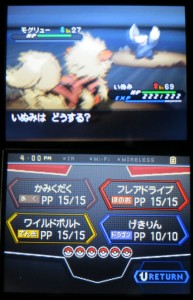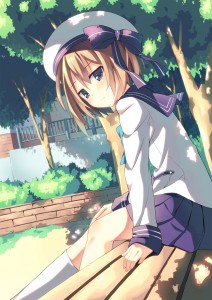In a post that Kai as posted this week about how video game is adapted into a show. While I have shared my thoughts about anime adaptations and challenges involved with it, video game adaptations are a different story as the experience is not static. As adaptations of video games (excluding visual novels) become more popular as seen adaptations of The Idolmaster, Persona 4 and Neptunia, how do they achieve this while making it enjoyable? (Image Source)
When you play a game, you probably do things differently such as using different tactics or strategies to defeat a boss or perhaps making different decisions to influence the story and the ending. Essentially the game play experience is not always the same since we will play it differently each time we start a new game. Not only that, everyone’s gameplay experiences is different. This makes you wonder how anime studios include every aspect of the game and it’s story. There are many ways to do this, first being a loose adaptation.

Loose adaptations are basically taking some parts of the story from a game and streamlining it into a show with original material. This is usually the most common method as video games usually have various arcs and have multiple endings. Because of that, it’s nearly impossible to cover them all in the main story and therefore, the production team can only cover chunks of the main story. For instance, in the Hyperdimension Neptunia Anime, they first introduced the main goddesses and then take the main stories from the second and third games and then incorporated them. While not the whole story is going to be told, at least the viewer gets a general idea of the story and might decide to play with the source material. However, a loose adaptation is risky and can backfire if it’s not done correctly and focuses too much on original material. For instance, Shining Hearts is a good example of this because the show focused way too much on making bread rather than trying to regain Kaguya’s memories like in the game.
Besides a loose adaptation, perhaps companies want to adapt the whole story faithfully, but can only focus on the important parts. While this type of adaptation is obvious, some shows used the omnibus format with each girl finally receiving an equal chance. While Amagami and Photo Kano are games that was made by the same company that used this format, Yosuga no Sora also done the same, but a bit differently by having a main story and separate character arcs mixed together. While I prefer to see each girl receive a happy end, people can become disinterested in the show if a particular character doesn’t interest them. At least this format prevents an all out shipping war in the fandumb and complaints that the first girl always wins.

While the method of adaptation of a story can vary, there are some obvious changes. Once of them are voiceless protagonists. While most Japanese role-playing games these days are fully voiced and don’t allow a person to change the character’s name, a few allow people to change the name for the character (especially older games) and they might be even voiceless. The main protagonist tends to be speechless in some of these games since he/she supposed to represent you, the player. In some games like The Idolmaster and most visual novels, they don’t show the main character’s body at all. Still, when the show gets an adaptation, besides being given a voice, they can give a generic appearance to represent the main character and receive more character development.

The second major difference between the show and the game is how it handles battles. When people play a role-playing game, the game expects you to choose what to do in a battle and level grind so your characters can become strong. In the Anime, this doesn’t exist since the story is static in nature. However, this can allow for more creativity since you aren’t confined by the limitations of the battle system. For instance, Pokémon is a good example of this since Ash’s Pikachu can dodge attacks and possibly use moves that can’t be learned in the actual game. Even with this degree of freedom, game play elements may still be incorporated to maintain the spirit of the actual game.
At the end of the day, it’s not exactly easy to make an anime adaptation of a video game and incorporate every aspect since video games are not static in nature. Even so, it’s impressive how some of these shows manage to make it an enjoyable experience by maintaining the spirit of the game. While not every aspect of the game will make it, if one can enjoy it, it can convince new fans of a franchise to play the game and experience everything for themselves.
What are your thoughts about anime adaptations of video games in general? Do you go out and play the game after finishing one of these shows?



Adapting games and visual novels to anime is definitely tricky – ones has gameplay elements to worry about while the other one usually contain multiple routes to go for, unlike media like anime, manga and light novels with a more “fixed” content. So far, I had seen two kinds of visual novel adaptions, one that choose a certain route to adapt, and one that squish in all the heroines routes, as in the case with Amagami SS and Yosuga no Sora as you said. I’m not even sure which I prefer here, lol, the former one could be a problem if the anime adapts the lesser interesting routes of the game, but usually these kind of routes are the ones that are better for introduction to the series, though their lack of appeal could be a problem. The latter obviously suffers from limitations and awkward “time resets” to reset back to where the plot diverges to one of the heroines. One thing I applaud Little Buster anime is that they are able to adapt all the heroines (except for a particular character) without using any “time reset”, though I think it’s something to do with it’s context.
Games protagonist without voices is an interesting element when compared to it’s anime counterpart, if it actually had an adaption, that is. Comparing anime to games like Idolmaster, the latter definitely had better immersive qualities. In it’s anime adaption however, a generic character design had been crafted just for it, together with a voice actor. Having these elements however, decrease it’s immersive qualities, turning the series immersive first-person perspective to a third-person.
I agree that to a certain extent, visual novels are a bit more dynamic compared to light novels as you pick your own adventure. In that regard, it’s clear that it’s going to be a bit more difficult as both methods of adapting a visual novel has some pros and cons. To me, it really depends on the type of story and the characters. With something like Little Busters, I wouldn’t mind too much because it’s better to see the overall story and then perhaps play the game to see the rest. Still, I think role playing games and other games are more dynamic and trickier to adapt as there is so many variables than just telling the story.
On the other hand, I understand that there are limitations to adapting a story which is told in a first person view. It’s mostly because there isn’t really any set personality and it heavily depend on the choices one makes in the game. In a sense, turning this character as a third person may loose some of it’s immersive qualities as you mention, but if it’s done correctly, I think it can be enjoyable and perhaps convince people to play the game themselves to have their own experience.